Did the Americans go to the moon?
How much time has passed since the day of "a small step for a man and a big leap for mankind", and some still cannot reconcile themselves to the fact that the "Moon Race" was won by the Americans, and even the Americans themselves are among the "non-reconciled". They support their disagreement not only by their unwillingness to be fooled by their government, but also by seemingly serious theories. But as it turns out, a huge number of small errors leads to a huge delusion, as you will see as you read on. To a very big and very stupid delusion.
How often a being whose main mental function is felt is born into a family with strong mental values that will block and prevent the full development of that person in his own natural patterns, which will then take him, his real opportunities, turning into a misunderstood, inadequate and unsuccessful existence in their enterprises. Like the alchemical crucible that supports the experiments done on it, the lunar figure, found in any relationship that supports manifestation, nourishment, growth, transformation, and childbirth, is far from reflecting, as traditionally attributed to her, the role of the biological mother.
Secrets of photographs from our satellite - the Moon |
The battlefield and cold war between the USSR and the USA has moved to space. In fact, there has never been a more useful war in the entire history of mankind: they began to compete in their development without harming each other, and international recognition and respect became the measure of victory. NASA joined the space race, lagging behind the USSR. On October 4, 1957, the USSR launched the world's first artificial Earth satellite. And the attempt by the Americans to launch their first satellite, Avangard, on December 6 of the same year, turned into a national disgrace: the launch vehicle exploded without even having time to break away from the launch device. However, over time, the gap began to narrow: on April 12, 1961, Yuri Gagarin flew into space, and already on May 5, the first American, Alan Shepard, visited space (although not in orbit). Less than a year later, on February 20, 1962, John Glenn made a full-fledged orbital flight. NASA began to catch up with the Soviet Union and overtook it, landing the first people in the history of mankind on the moon, which is considered the greatest achievement of civilization, the next step in evolution. Some do not want to put up with it and say: "Is it so?!".
Yes, here, and so they put the question squarely! "This," they say, "is all a falsification! The Americans weren't on the moon!" - they shout at the top of their lungs, sometimes even providing serious evidence. There is more and more evidence all the time, indirect and direct, stupid and not very, refutable and not quite. So, the arguments that supporters of the theory of falsification provide are marked in italics.
The photographs are some of the strongest evidence for the rigging of the moon flight. "The photos and videos speak for themselves." Only Mr. Percy is not a photographic specialist, since he does not know a few simple things. The first thing that comes to mind as an objection is: let's say the picture was taken in a pavilion with several different spotlights. So why don't both astronauts have four shadows, like football players at matches? Spotlights shine selectively, or what? Well, come on, let's leave the searchlights alone, let's go back to the moon:
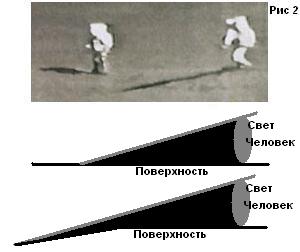 |
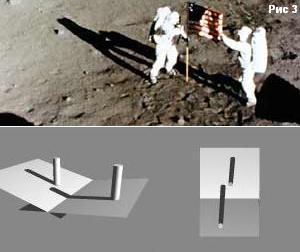 |
This is not a photograph, but a frame from a movie. The movie camera was fixed in the lunar module (behind the porthole) and could work without the participation of astronauts. And the shadow from a street lamp is the longer, the farther a person stands from it. Here, everything is just the opposite: the astronaut who is closer to the light source has a longer shadow. The reason is the same: the surface on which the shadows fall is uneven. The figure on the right, taken from http://www.clavius.org/, simulates this situation:
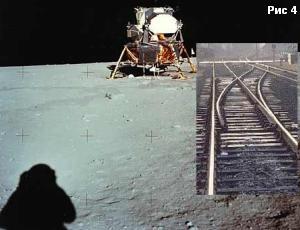 |
 |
But perspective can. Look at the photo on the right here. Equally strange things are happening on it: the rails on the right also "suffer from left bias", and this effect gradually fades away as you move to the left side of the image. And the rails must certainly be parallel so that the trains do not leave them! As is well known, parallel lines in the terrain in a photo will appear to converge to a single point on the horizon. This is exactly what we see in these photos. Here is another photo that is often cited as evidence of fake lunar images. There is the same tendency for the shadow directions to converge to a horizon point located somewhere near the left border. And the only strange thing here is that the behavior of parallel lines seems strange to some.
Um. And what prevented them from removing the "most odious shadows" before they hit the media?
But after all, the one who riveted the photographs could not have put these very shadows from the very beginning.
Well, I read this voluminous explanation that the shadow from one of the pillars is not going the way it should... NO, NO and NO! Well, look, there are also telescopic, (extending / shortening) supports to stand up steadily and adapt to the surface. The moon is not a billiard ball, it is all in the hills, and these four "legs" are DIFFERENT
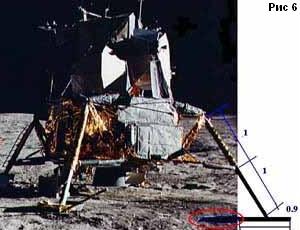 |
 |
In fact, there is no atmosphere on the Moon. But there is a lunar surface that scatters the light falling on it in all directions. (Some of the scattered light reaches the Earth, and it is enough to be able to read on a full moon.) This scattered light partially hits the astronaut and illuminates him. The astronaut's suit is white, and the ambient light is enough to make something visible in the shadows.
Have you seen many Hollywood films where spotlights appeared in the frame? You take the Nazis for fools. Wouldn't they have been able to arrange the lighting fixtures so that they did not fall into the frame, or, at worst, cover them up in the photograph? These spots are simply glare caused by the repeated reflection of sunlight from the lens surfaces of the lens. Judging by the shadow of the astronaut, the Sun was not far from the edge of the frame, so direct sunlight hit the lens when shooting. The lens has an axis of symmetry. Therefore, highlights should be located in a straight line from the center of the frame. And searchlights are not at all required to line up along such a radial ruler. The center of the frame is indicated in the photo by a large cross. Let's draw a line from it through these spots. As can be seen, both spots are located on this line, and their shape is symmetrical with respect to it. Exactly what one would expect from the glare of optics. There are quite a lot of photographs with such "searchlights" on NASA sites - NASA employees demonstrate them and for some reason are not afraid of being accused of forgery. In these photographs, white spots also lie on a straight line passing through the center of the frame marked with a large cross (if this cross is visible). Take a look for yourself:
- "Apollo 11":
1. Moonquakes
The mother who brings physically is the Earth. The Earth-Moon connection, from an astronomical point of view: a "partnership" situation. All over the Earth we see the awakening of the natural, everyday Sun, as well as our individual lives. In Greco-Roman myth, which is the basis of the astrology we use in the West, the Moon helps the mother in the birth of her brother San and, seeing the suffering that the mother goes through, asks her father Zeus to give her the privilege of remaining a virgin. She, from birth, is the one who cares, who protects, who supports and helps, and then she will always fulfill her functions as a protector of nature and animals.
Despite the fact that, in fact, the Moon is just a dead piece of rock with extremely low geological activity, crustal movements occur there too. They are called moonquakes (by analogy with earthquakes).
There are four types of moonquakes: the first three - deep moonquakes, fluctuations from meteorite impacts and thermal moonquakes caused by solar activity - are relatively harmless. But moonquakes of the fourth kind can be quite unpleasant. Usually they are up to 5.5 points on the Richter scale - this is enough to start shaking small objects. These shocks last for about ten minutes. According to NASA, such moonquakes cause our Moon to "ring like a bell."
In this case, midwives, nannies, housewives, nurses, nurses, doctors and all beings who provide support, security and shelter are lunar. This separation of roles, Earth and Moon, gives us, as an astrological resource, the ability to visualize potential gifts at birth, through planetary transits, to the position of Earth on the mother's birth chart at that moment.
This question becomes more impressive if we consider the aspects that exist between the Moon and the Earth, not only in the natal chart of the one who will give birth, but, above all, aspects of the moment of birth, since the Moon of this moment will be the same chart of the child in his dynamics with the chart of his mother. This observation, which must be taken as a whole, must be centered on the Earth and Ascendant of the parent. Babies born at a time when the Moon is at a tense angle to Mother Earth tend to have more difficult or laborious births as the support and support needed for the mother's biological nature may be inadequate, absent, or something detrimental to the needs of the moment.
The most frightening thing about these moonquakes is that we have no idea what exactly causes them. Earthquakes on Earth are usually caused by the movement of tectonic plates, but there are simply no tectonic plates on the Moon. Some researchers think that they may have some connection with the tidal activity of the Earth, which, as it were, "pulls" the Moon on itself. However, the theory is not supported by anything - tidal forces are associated with full moons, and moonquakes are usually observed at other times.
In these cases, as far as possible, postponing the birth in minutes may already bring about relief in this tension, as the moon's step is rapid and the most difficult aspect can be divorced in a very short time. But, returning to the conscious function of Astrology, we find, besides this Sun-Earth relationship, fertilization and generation, as well as lunar figures in our lives. The moon, in addition to being able to find its functions in the care, shelter and shelter provided by the biological mother herself, can also fulfill these functions in the figure of a grandmother who creates her grandson as a person who receives a child, a nanny who takes care while mothers work outside the home, in the end after all, parents, brothers, uncles and aunts, characters who love the world of children, regardless of social role, gender or physiological determinants.
2. Double planet

Most people are sure that the Moon is a satellite. However, many argue that the Moon should be classified as a planet. On the one hand, it is too large for a real satellite - its diameter is a quarter of the diameter of the Earth, so the Moon can be called the largest satellite in the solar system, given this ratio. Pluto, however, also has a satellite called Charon, whose diameter is equal to half the diameter of Pluto itself. Only now Pluto is no longer considered a real planet, so we will not take Charon into account.
This acceptance and acceptance will certainly establish the affective basis from which we will accept and approve of ourselves. As Lutz Müller says in his beautiful book The Hero, "The glow and suffering of our existence is hidden in the eyes of the first person in our lives."
We also know through the infinite wisdom of Astrology contained in relation to Heaven and Earth that we have the opportunity to experience all forms of the Moon, all its qualities, both in our daily transit and in its progressions. We learn through Astrology to embrace the potential present in each person, knowing that each is the fruit of a unique and special act of love, has its own meaning, and has an expressive and essential role in the human trajectory.
Because of its large size, the Moon is not actually in Earth orbit. The Earth and the Moon revolve around each other and around some point in the center between them. This point is called the barycenter, and the illusion that the Moon is orbiting the Earth is caused by the fact that the center of gravity is currently inside the Earth's crust. It is this fact that does not allow us to classify the Earth with the Moon as a double planet, but in the future the situation may change.
The card of this loving union guides and gives meaning to Life. We worked together, the client and I, as if his map were a twelve-room house. These tables are taken from their house house cusps and the planetary positions contained therein. In each "individual month," the individual must enter into a notebook his main impressions of the period and special dates, in whatever way suits him best. This expression changes according to the main tendencies of each and is used during the sessions.
For some, writing is the best form, others express their perception through drawings, collages, fantasies experienced by poetry, photographs, dreams, films that impressed them, texts and phrases they read or heard, and so on. Thus, the passage of sunlight and shadow projected by the Earth on the natal chart will feel as if a room of this "house" is being illuminated and opened up to consciousness. Similarly, the "pieces" contained in each room will also be cleared and perceived by the shadows they generate, which can be projected onto events and people in a person's life.
3. Lunar debris

Everyone knows that there was a man on the moon. But not everyone knows that Man (let's write this word with a capital letter on purpose) used the Moon as a standard place for a picnic - the astronauts who visited the Moon left a lot of garbage there. It is believed that about 181,437 kg of artificial materials rest on the surface of the moon.
Shadow formation, understood as the formation of a region devoid of light, is a consequence of the principle of rectilinear propagation of light. Imagine a very small object emitting light. When the light emitted by an object is the only source in a certain area of space, then the object at a certain height from the ground creates a shadow in it.
This is because the light will not continue when the object is found, creating an area where there is no light. Other rays propagating in straight space reach the floor or another object, creating lighted areas and areas without light.
Of course, not only the astronauts are to blame - they did not deliberately scatter sandwich wrappers and banana peels on the Moon. Much of this debris is from various experiments, space probes and lunar rovers, some of which are still operational.
4. Moon grave

If the light source is an extensive, most common case, then we will have areas not hit by the light beam and areas hit by the light beam. These areas of varying degrees, depending on the amount of light, are areas of penumbra.
Consider a spherical body, which is an obstacle to the propagation of light, located between the light source and the partition. The shadow area in a spherical body and the shadow itself. The region of shadow between the spherical body and the baffle is shaped like a cone and is therefore known as the shadow cone. A shadow is formed in the bulkhead or a shadow is projected.
Eugene "Gene" Shoemaker, a well-known astronomer and geologist, is something of a legend in his own circles, having developed methods for the scientific study of cosmic impacts and also invented the techniques that Apollo astronauts used to explore the moon.
Shoemaker wanted to be an astronaut himself, but was unable to get the job due to minor health issues. This remained the biggest disappointment of his life, but Shoemaker nevertheless continued to dream that he would one day be able to visit the moon himself. When he died, NASA fulfilled his deepest wish and sent his ashes to the moon with the Lunar Prospector in 1998. His ashes remain there, scattered among the moondust.
In the case of an extensive source and under the condition of a uniform spherical source, the shadow itself is obtained in a spherical object located between the source and the bulkhead, the shadow projected in the bulkhead, and the penumbra projected in the bulkhead. The half-light is partially illuminated. The partially illuminated area between the spherical body and the partition is a penumbra cone.
In the previous cases, when we analyze the shadow and penumbra regions of bodies and spherical sources, it is important to understand the phenomenon of eclipses. This is a natural phenomenon that occurs relatively often. The last total eclipse of the recorded Sun occurred in the way the Sun, Moon and Earth are spherical bodies, worthy of the earlier considerations regarding shadow and penumbra.
5. Lunar anomalies
Some of the images taken by various satellites show very strange things on the surface of the moon. It seems that there are artificial structures on the Moon, the size of which varies from very tiny, usually in the form of a parallelepiped, to "obelisks" at least 1.5 km high.
Fans of paranormal phenomena even "found" among these objects a large castle, "hanging" high above the surface of the moon. All this seems to indicate an advanced civilization that previously lived on the moon and allegedly built complex structures.
An eclipse of the Sun occurs when the Moon is between the Sun and the Earth. The sun is eclipsed by the moon. We call a total eclipse of the Sun a situation in which some areas of the Earth enter the moon's shadow. Regions that enter the twilight cone of the Moon perceive a partial eclipse.
There may also be another type of solar eclipse: an annular eclipse. In this type of eclipse, a certain area of the Earth enters the elongation of the Moon's shadow cone. As a consequence, these areas will only be exposed to light coming from the Sun's periphery. In this case, the central part is eclipsed by the Moon. Annular eclipse of the Sun. Since these areas are in the twilight of the Moon, such an eclipse is partial.
NASA has never debunked these strange theories, despite the fact that all the pictures are most likely faked by conspiracy theorists.
6. Moon dust
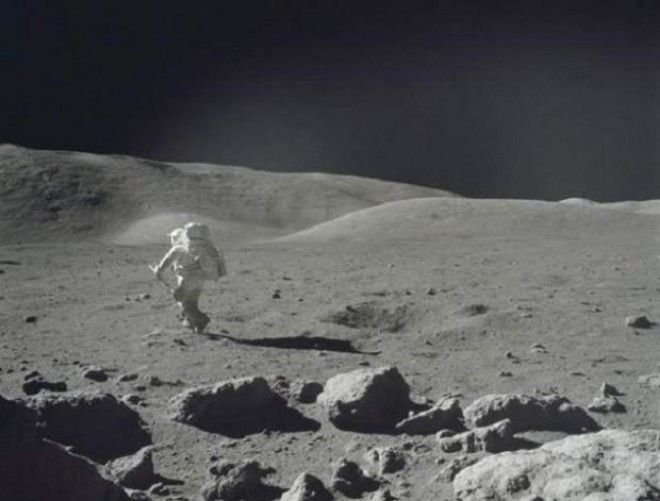
One of the most amazing and at the same time the most dangerous things on the moon is lunar dust. As everyone knows, sand penetrates everywhere on Earth, but the dust on the moon is an extremely dangerous substance: it is fine, like flour, but at the same time very coarse. Thanks to its texture and low gravity, it penetrates absolutely anywhere.
When does a solar eclipse occur? From the very beginning of history, eclipses have caused surprise and horror in its observers. At the present time we know what causes eclipses, but nevertheless, interest in these astronomical phenomena remains very relevant. In general terms, an eclipse can be said to be an occultation or obscuration of a celestial body by another celestial body relative to the observer. Usually when we talk about eclipses, we talk about solar eclipses or lunar eclipses because they are more obvious.
But there are other types of eclipses, such as those that occur in binary systems of stars when one of the stars passes "ahead" of the other, reducing the brightness of the binary system. We call these stars eclipsing binaries. A solar eclipse occurs when the Sun, Moon and Sun align, being the Moon between the Sun and Earth. In this case, our planet passes through the shadow projected by the Moon. For an eclipse of the Sun to occur, the Moon must be in its new Moon phase and at the same time be in the same plane around it around the Sun's Earth - a situation that does not always occur since the Moon's orbit around the Earth has an inclination of about 5° relative to the plane earth's orbit around the sun.
NASA has had numerous problems with lunar dust: it tore apart astronauts' boots nearly completely, seeped into ships and spacesuits, and caused "lunar hay fever" in unfortunate astronauts if they inhaled it. It is believed that with prolonged contact with lunar dust, any, even the most durable object, can break.
In most cases when the phase is out of the Moon, the Moon projects its shadow "above" the north pole or "below" the south pole of our planet due to this tilt of the orbit. There are 3 types of solar eclipses: total, annular and partial. Before we look at each of them, it's important to keep in mind that the diameter of the Sun is about 400 times the diameter of the Moon and that the Sun is about 400 times larger than the Moon, Earth, Sun and Moon appear to be pretty close in size. . But the distance between the Sun and the Earth and the distance between the Earth and the Moon change with time, so that in some cases the size of the Moon is slightly larger than the size of the Sun, and in other cases the Sun appears slightly larger than the Moon.
Oh, by the way, this devilish substance smells like burnt gunpowder.
7. Difficulties with low gravity
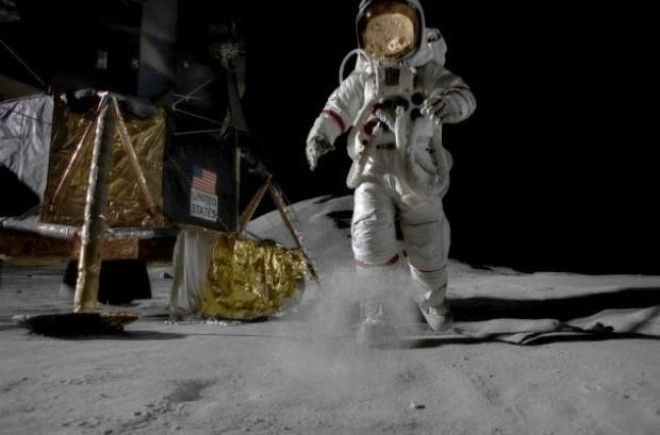
Although the gravity on the moon is only one-sixth that of the earth, moving on its surface is quite a feat. Buzz Aldrin said that it would be extremely difficult to establish settlements on the Moon: the legs of astronauts in bulky spacesuits were almost 15 cm buried in lunar dust.
A Total Eclipse of the Sun occurs when the size of the Moon as seen from Earth is large enough to completely "cover" the Sun. When this phenomenon occurs, it is only visible in a narrow band on the surface of the Earth, and in areas close to this range, it can be an observation of a partial eclipse of the Sun. In comparison, when a total eclipse of the Moon occurs, this eclipse can be observed over the entire part of the Earth that is at night, but in relation to a total eclipse of the Sun, it is not visible in the entire region that is on that day, given that the Moon's shadow on the Earth's surface is much smaller, covering only a small part of it.
Despite the low gravity, human inertia is high on the Moon, making it difficult to move quickly or change direction. If the astronauts wanted to move faster, they had to pose as clumsy kangaroos, which was also a problem, since the Moon is full of craters and other dangerous objects.
8. Origin of the Moon

Where did the moon come from? There is no simple and exact answer, but, nevertheless, science allows us to make several assumptions.
There are five main theories about the origin of the moon. The fission theory claims that the Moon was once part of our planet and separated from it at a very early stage in the history of the Earth - in fact, the Moon could just be in the place of the modern Pacific Ocean. The capture theory says that the moon simply "wandered" through the universe until it was captured by the earth's gravity. Other theories say that our satellite either formed from the debris of asteroids, or was left from the collision of the Earth with an unknown planet the size of Mars.
The most reliable theory of the origin of the Moon so far is called the Theory of the Rings: a protoplanet (a planet that is just being formed) called Theia collided with the Earth, and the cloud of debris that formed after that eventually came together and turned into the Moon.
9. Moon and sleep
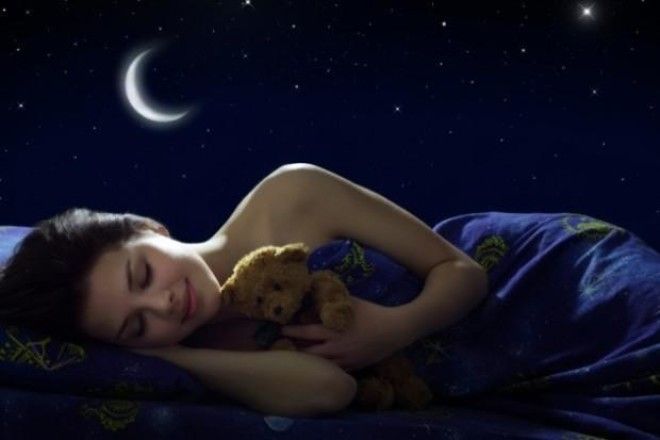
The influence of the Moon and the Earth on each other cannot be denied. However, the influence of the Moon on humans is a source of ongoing debate. Many believe that the full moon is the cause of the strange behavior of people, but science cannot provide conclusive evidence for or against this theory. But science agrees that the moon can disrupt the cycle of human sleep.
According to an experiment conducted at the University of Basel in Switzerland, the phases of the moon affect human sleep cycles in a very specific way. Worst of all, people sleep, as a rule, precisely on the full moon. These results can fully explain the so-called "lunar madness": according to the experiment and the assurances of many people, it is on the full moon that they most often have nightmares.
10. Moon shadows
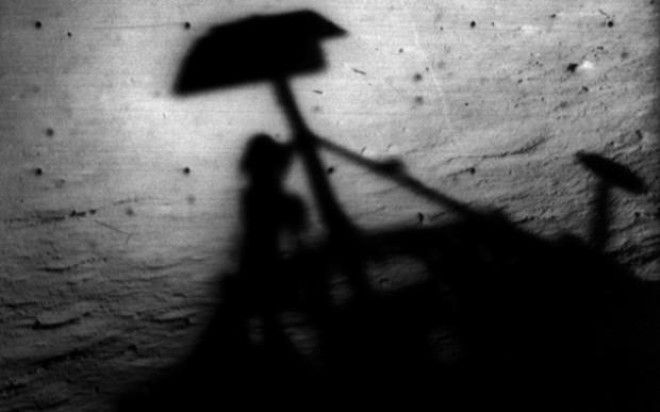
When Neil Armstrong and Buzz Aldrin first set foot on the Moon, they made an amazing discovery: the shadows on the Moon are much darker than Earth's shadows due to the absence of an atmosphere. All moon shadows are completely black. As soon as the astronauts stepped into the shadows, they could no longer see their own feet, despite the disk of the sun glowing brightly in the sky.
Of course, the astronauts were able to adapt to this, but such a contrast between dark and light areas of the surface still remained a problem. Astronauts have noticed that some shadows - namely their own - have a halo. They later learned that the eerie phenomenon was due to the opposition effect, in which some dark shadow areas appear to have a bright halo, provided that the observer looks at the shadows at a certain angle.
The shadows of the moon have plagued many of the Apollo missions. Some astronauts found it impossible to complete spacecraft maintenance tasks because they couldn't see what their hands were doing. Others thought that they accidentally landed in a cave - such an effect was created due to the shadows cast by the slopes.
11. Lunar magnetism
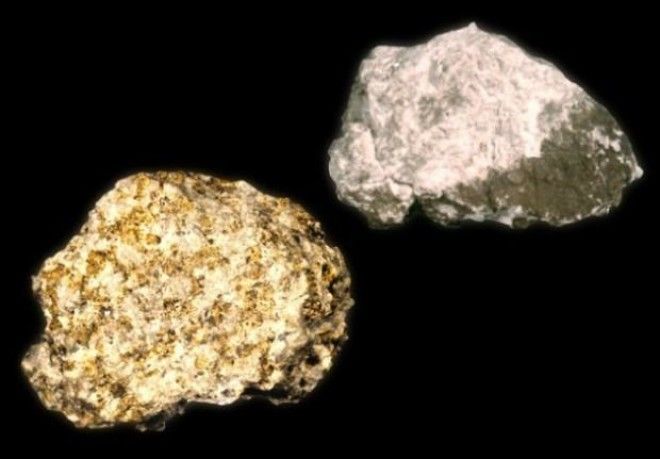
One of the most interesting secrets The moon is that the moon has no magnetic field. Surprisingly, at the same time, the stones that astronauts first brought from the Moon to Earth in the 1960s had magnetic properties. Maybe the stones are of alien origin? How can they have magnetic properties if there is no magnetic field on the Moon?
Over the years, science has established that the moon once had a magnetic field, but so far no one can say why it disappeared. There are two main theories: one says that the magnetic field disappeared due to the natural movements of the moon's iron core, and the second claims that this may be due to a series of collisions of the moon with meteorites.



